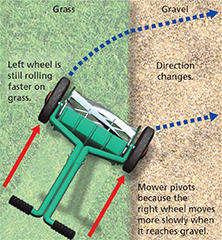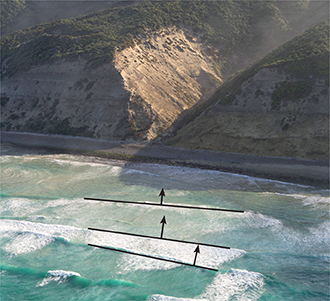Refraction
Refraction is the bending of a wave as it enters a new medium at an angle. Imagine pushing a lawnmower from grass onto gravel, as shown in Figure 9. The direction of the lawnmower changes because one wheel enters the gravel before the other one does. The wheel on the gravel slows down, but the other wheel is still moving at a faster speed on the grass. The speed difference between the two wheels causes the lawnmower to change direction. Refraction changes the direction of a wave in much the same way.  When a wave enters a medium at an angle, refraction occurs because one side of the wave moves more slowly than the other side.
When a wave enters a medium at an angle, refraction occurs because one side of the wave moves more slowly than the other side.
Figure 9 A lawnmower turns when it is pushed at an angle from the grass onto the gravel.
Relating Cause and Effect Explain why the lawnmower straightens out after both wheels are on the gravel.
 d
dFigure 10 shows the refraction of an ocean wave as it flows into a shallow area. The shallower water can be considered a new medium. The lines on the photograph show the changing direction of the wave. These lines, called wave fronts, are parallel to the crests of the wave.
Notice that the wave fronts approach the shore at an angle. The left side of each wave enters shallower water before the right side does. As the left side of the wave slows down, the wave bends toward the left.
If a wave front is parallel to the shoreline, the wave enters the shallower water all at once. The wave will slow down but it will not change direction. Refraction of the wave occurs only when the two sides of a wave travel at different speeds.
 What is refraction?
What is refraction?
Figure 10 As an ocean wave approaches the shore at an angle, the wave bends, or refracts, because one side of each wave front slows down before the other side does.





